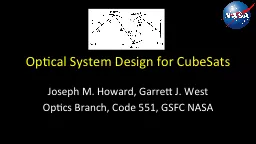

Joseph M Howard Garrett J West Optics Branch Code 551 GSFC NASA Agenda Optical Design Lab ODL Optical Specifications Refractive vs Reflective Freeform Optics Examples 2 Welcome to the ODL ID: 807340
Download The PPT/PDF document "Optical System Design for CubeSats" is the property of its rightful owner. Permission is granted to download and print the materials on this web site for personal, non-commercial use only, and to display it on your personal computer provided you do not modify the materials and that you retain all copyright notices contained in the materials. By downloading content from our website, you accept the terms of this agreement.
Slide1
Optical System Design for CubeSats
Joseph M. Howard, Garrett J. WestOptics Branch, Code 551, GSFC NASA
Slide2Agenda
Optical Design Lab (ODL)Optical Specifications
Refractive vs. Reflective
Freeform Optics
Examples
2
Slide3Welcome to the ODL!!
Optical Design Lab (ODL): Goddard Optics Branch, Bldg
5, Room W054
We provide optical design services, and a gateway to the Engineering Technology Directorate (ETD)
Contact: Joe.Howard@nasa.govThe conversation starts with specifications
…
3
Slide4Optical Design Specification
What is the NAME
of your mission, the basic concept (one or two sentences), and the top level science requirements ? Are there "competition sensitive" aspects of this study that you need us to be aware?
Are there
s
chedule
constraints ? (e.g. Instrument Design Lab, IDL, or Mission Planning Lab, MPL, run in a few weeks, etc.)
Number
of instruments ? (typically this is just one)
4
Slide5Optical Design Specification
Conjugates
? Is your object of interest at infinity, which is to be imaged onto a detector? (This case is the most common.)
Aperture
? Is this defined as an Entrance pupil diameter (EPD) ? Or a working F/# ? Is this requirement driven by radiometry (i.e. sensitivity), or resolution (i.e. diffraction limited) ?
Field of view
(FOV)
?
Do you have a detector concept in mind? If so, tell us the pixel size and array size.
5
Slide6Optical Design Specification
Focal Length or Magnification
? What is your desired Pixel sampling on the object of interest (e.g. sky or ground) ?
O
ptical performance figure of merit ?
Wavelength range
? (i.e. optical
bandpass
)
If the instrument is a spectrometer, please include desired spectral resolution.
Systems requirements
?
Strongest engineering driver: cost, volume, mass, or performance?
Any optically important mechanisms (e.g. scan or steering mirrors)?
Any significant packaging or mass constraints for this instrument?
6
Slide7Design Solutions: Refractive
Plot
Aperture (F
/
#) vs FOVRefractive can be more compact
Large
bandpass
may require many lenses for chromatic correction
Mass adds up for complex systems
Glass may be sensitive to radiation environment
Larger field of view capabilityThroughput may be impacted depending on glass transmittance and number of surfaces
LENSES
7
Slide8Design Solutions: Reflective
Large
bandpass
are easy to accommodate
Larger Fields are challenging to packageUsually higher throughput compared to glassFreeform shapes can help with packaging and performance…
MIRRORS
8
Slide9Freeform Optics
Definition
: a mirror or a lens with a non-rotationally symmetric surface, typically with large departures from a best-fit spherical surface (many um to mm).
Enables
:
Wider FOV
Better
Image Quality
Smaller
Reduce number of components
Conic Relay
Freeform
Relay
3 mirror
Asphere
Telescope
Traditional Optics
FREEFORM
S
maller
Less mirrors
9
2-mirror Freeform
Slide10Example System: Focal
2-mirror telescope, 1UField correction lens
UV capable
40 mm Pupil
3D printedE.g. NEAS
10
Slide11Example System: Afocal
2-mirror afocal
telescope
Pupil imaging concept
UnobstructedInternal Field StopSquare pupilE.g.
BIRCHES,
etc.
11
Slide12Example: Simple Spectrometer
Refractive objective
Internal Field Stop
Refractive Collimator
Linear GratingRefractive CameraE.g. SHILO
12
Slide13Example: Wide-Field
Imager
Refractive, 3 U design
80 mm pupil
10 deg fieldCan cover
UV
E.g., CUTIE, GUCI, etc.
13
Slide14Example: Freeform
2 U 2-mirror focal system
50 mm pupil, deployed
Large Field (3 x 9
deg)F/5Can be folded
Efficient with
space
E.g. XY
Penta
14
Slide15Example: Freeform
1 U 2-mirror focal system
20 mm pupil, two channel
Large Field (~4x8 degrees)
F/3.2Efficient with spaceE.g. PROVE
15
Slide16Concluding Remarks
The minimum aperture size of optical instrumentation is often driven by the laws of physics, so miniaturization of optics is often not an option for science applications.
Freeform optics are enabling smaller optical systems of a given aperture with large fields of view
.
If you need help with your optical design, contact the Optical Design Lab (ODL): Joe.Howard@nasa.gov
16